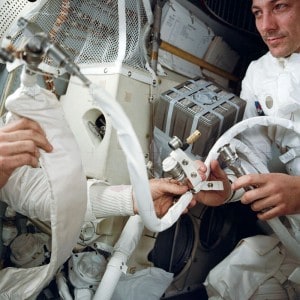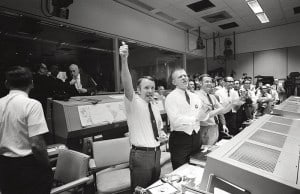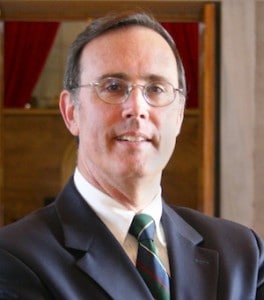I believe we’ve had a problem here.
—Jack Swigert, command module pilot on Apollo 13, April 13, 1970—
Part One
Apollo 13 was launched on time from the Kennedy Space Center on April 11, 1970 at 2:13 p.m. EST. Its crew was Commander James Lovell, Command Module Pilot Jack Swigert, and Lunar Module Pilot Fred W. Haise. Apollo 13 was to be the third manned space flight to land on the moon. Soon after the launch, an anomaly occurred in which the second stage engine stopped early, but engines in the third stage burned longer than had been planned, compensating for the early shutdown.
For a little more than the first two days beyond this event, no serious problems arose. Then, 55 hours, 55 minutes, and 4 seconds from launch—an explosion occurred.1 At the request of Mission Control [MC], command module pilot Jack Swigert pressed a button that initiated a necessary, routine procedure, one that stirred the super-cold [cryogenic] oxygen and hydrogen stored in tanks aboard the service module [SM].2
Because of a design flaw in the tanks, wiring insulation had been damaged. When a spark jumped between the wires in one of the oxygen-rich tanks, Apollo 13 shook violently.3 As the cryogenic gasses escaped, the ship’s “capability to generate electrical power, to provide oxygen and to produce water” decreased sharply as well. When the service module was jettisoned before the command module’s re-entry into the earth’s atmosphere, the crew at last was able to see it. Photographs “showed one whole panel missing, and wreckage hanging out, it was a sorry mess as it drifted away.”
Of course, no one immediately knew the full extent of the damage—only that something was very wrong. CM pilot Jack Swigert told MC in Houston, “I believe we’ve had a problem here.” Indeed. This was only the beginning!
As the specifics of the crisis became increasingly apparent, Mission Control realized that landing on the moon was now a no go and that without hard work, brainstorming, creativity, and very good fortune, the crew would forever be lost in space. Commander Lovell later said, “The odds were very small that we were going to get out of this alive.”
Apollo 13 had traveled 200,000 miles since its launch and now was 45,000 miles from the moon’s surface. At this point in the journey the moon’s gravitational pull was beginning to supersede that of the earth.4 This would become a key factor in the plan to bring the crew home. Former NASA Lead Flight Director Gene Kranz recalls that he and his men assessed and ran calculations on “the limited resources available in the damaged spacecraft. For the moment the power and the oxygen in the CSM [command and service module] would keep the crew alive but the LM [lunar module] was ultimately the only safe haven,” even though it had not been designed or equipped to accommodate the entire crew for a 4-day return trip to the earth.5
Soon Kranz was advised,
We have two basic options, a direct abort and one going around the Moon. The fastest direct abort gets us home in thirty-four hours. We fly in front of the Moon but we have to jettison the LM and use all the main engine fuel. We have several options that fly around the Moon. The best one takes two days longer, but we don’t use the main engine and we can keep the LM.6
Going around the moon also would utilize the moon’s gravity to pull the spacecraft “in an arc toward a rendezvous point with Earth,”7 but a multitude of factors had to be considered. The team “rapidly went through the mathematics; the lunar module was good for two crewmen for two days. A quick estimate using the LM powered-down checklists and taking the path around the Moon left us at least thirty six hours short on battery power.”8
Despite this drawback, the team reached a consensus that a direct abort was too risky. Moreover, going around the moon would buy Mission Control time to resolve the power shortage problem.9 With an overall plan in place, the crew retreated into the LM, and they and Mission Control powered down the CM, reserving its precious resources for later when it would bring the crew on its final leg of the journey back to earth. The move to the LM was timely, because life support and other resources the CM were ebbing fast.10 Some problems still were unresolved, and others would arise as the crisis continued to unfold.
Mission Control and the crew of Apollo 13 overcame nearly impossible odds. At one point, the crew had to perform a maneuver to rotate the spacecraft so it could be evenly heated by the sun’s rays. Jets were used to initiate the rotation, and without great precision, the craft would wobble. The procedure never had been performed using LM jets when both of the main sections of the spacecraft were docked. Furthermore, the jets on the LM were awkwardly located to initiate a smooth rotation in both modules. Apollo 13 wobbled on the first attempt, but fortunately, not on the second.11
Yet another life-threatening problem occurred when the ventilation scrubbers in the LM (which, as we have noted, had been designed and equipped for two men for two days) had been used up. Without these, carbon dioxide was slowly filling the cabin and poisoning the three-man crew. Command module air scrubbers were available, but these were incompatible with the LM. With speed, resourcefulness, and ingenuity, Mission Control personnel designed an adapter with on-board materials and instructed the crew on how to put it together.12
A tenacious Mission Control was able to solve one problem after another. Ultimately the power shortage problem was resolved as MC brainstormed and worked with resourcefulness and ingenuity, given the limitations and other particulars of the situation at hand. The crew was returning home, but in great discomfort. Not only did the men have to deal with a lack of food and water, but they also couldn’t sleep because of the biting cold air. A temperature of 38° F resulted when the electrical systems were shut off, and condensation formed on the walls of the LM.
Finally, April 17, the day of re-entry, arrived. Normally on a lunar mission, because of the ionization of the air surrounding the CM during its descent to earth, a communications blackout period of about 4 minutes occurs. It’s a breathless time for those on the ground. In this case it was an especially intense cliffhanger, not just because of concern about possible damage to the CM’s heat shield because of the explosion, but also because the blackout period lasted six minutes.
Odyssey splashed down in the south Pacific Ocean at 1:07 p.m. EST on April 17, 1970, six days—142 hours and 54 minutes—after launch. Its recovery ship, the USS Iwo Jima, was four miles away, and within 45 minutes the ship’s crew had ushered Jim Lovell, Fred Haise, and Jack Swigert aboard. With the safe return of the crew, perhaps the most exciting and breathtaking chapter in the history of American space exploration ended.
Part Two
Today, we can liken Obergefell, the Supreme Court’s decision that redefined marriage nationwide, to the cryonics tank explosion that damaged Apollo 13 and imperiled its crew. We need to follow NASA’s example. Mission Control worked within the parameters and limitations of the situation at hand. With limited options, Gene Kranz and his team were able to snatch victory from the jaws of defeat because they accurately assessed the crisis and acted accordingly.
How can we save marriage? Even though the constitutional experts who say Obergefell is unconstitutional are correct, in practical terms the ruling of the Supreme Court carries legal weight that contrary legal opinions do not. Moreover, it isn’t just legal winds that blow in this direction, but cultural winds as well. While the Constitution means what it means, not what the Supreme Court says it means, too many people, including those in public office, believe that Obergefell is settled law because SCOTUS has ruled. Any effective strategy to rescue natural marriage must take these factors into account and work around them. Ignoring them actually will imperil marriage even further. Put another way, supporters of traditional marriage have limited options.
David Fowler, a former Tennessee state senator and the current president of the Family Action Council of Tennessee, says as much in an excellent article titled “Who Can Challenge Obergefell?” He explains that only two parties—the federal government and the state government—can challenge the Obergerfell ruling. These are not neutral parties. Governments at the federal and state levels have perspectives on the marriage ruling and practical authority to act on those perspectives. The same can be said of each branch of government at federal and state levels. Once we understand this, we also must accurately assess how each government entity is likely to respond to any challenge to the Supreme Court’s ruling on marriage. Fowler warns, “Failure to take into account both of these considerations will result in failure to effect change and protect the constitutional principles of federalism and separation of powers that are now at risk in future matters important to the state and its citizens as a result of Obergefell.” Beware! While a recommendation might sound good and even make a person feel good, these factors don’t mean it ultimately will produce the desired result. Some approaches would be akin to Mission Control’s ignoring the realities of the Apollo 13 crisis, even as it developed a plan to bring the crew home.
Fowler goes on in his article to describe the “lay of the land” with regard to the Obergefell ruling in the branches the federal government and in those of Tennessee’s state government. Even if you don’t live in Tennessee, pay close attention to Mr. Fowler. His insights have significant implications for other states.
At the federal level, President Obama supports Obergefell and will work to preserve it, and the current Congress has demonstrated it will not work to restore traditional marriage. We need to work to change both branches, but for now, we must understand the futility of strategies that rely on these entities.
In Tennessee, Fowler notes, the current governor has taken the advice of the state attorney general and stated “he believes the state must issue same-sex ‘marriage’ licenses, which also means that he believes that same-sex ‘marriages’ should be recognized for the purpose of all other state laws (e.g. tax laws, state employee benefits, etc.) the executive branch administers.” If the legislature, therefore, were to pass a law directing that state officials ignore Obergefell and not recognize same-sex marriages in Tennessee, it better understand that it is going head-to-head against the current governor and all future governors who agree with him. Under the constitutional principle of the separation of powers, the governor has authority to ignore laws he believes to be unconstitutional. The only way the legislature could enforce its law would be to impeach the governor! It is doubtful that any such effort would be successful. Furthermore, if the legislature passed a law affirming traditional marriage, the state would be sued in federal court, where judges have a track record of hostility toward state laws limiting marriage to one man and one woman. The state attorney general could decide, again, under the principle of separation of powers, not to defend the law. This, of course, would increase the likelihood it would be overturned. Without a new justice at the Supreme Court in the place of one of the five who comprised the Obergefell majority, we cannot realistically expect that such a state law ultimately would be upheld. These aren’t the only obstacles, either. Tennesee’s state courts provide an arena to be considered as well; we will consider that arena momentarily.
At this point it is critical that we remind ourselves of this: The prevailing question isn’t How can Obergefell be most directly challenged? but How can it be most effectively challenged? Given the current specifics, we do well to recall that even though a direct abort of Apollo 13’s journey to the moon would have brought the crew home in 34 hours if it had worked, MC wisely chose to send the spacecraft around the moon. Taking the longer route obviously offered its own set of challenges, but ultimately, the crew survived. I encourage you to read Fowler’s article in its entirety. Like Gene Kranz and Mission Control, David Fowler is assessing the crisis at hand with great understanding.
The prevailing question isn’t How can Obergefell be most directly challenged? but How can it be most effectively challenged?
Just what is Fowler’s recommendation for challenging the Obergefell ruling? In an article titled “How Should Tennessee Resist the US Supreme Court?” he speaks favorably of
a lawsuit over the constitutional problems created by Obergefell…, like the one pending before the Alabama Supreme Court.…
The lawsuit will give our state court judges an opportunity to judge the Obergefell decision. The legislature can then take whatever action is appropriate based on what our state courts, not the federal courts, say.
Unlike federal judges, Tennessee judges do have some accountability to the people. Trial judges run in contested elections and appellate judges stand for retention elections. Plus, Article VI, Section 6 of the state Constitution allows the legislature, by two-third’s vote, to remove judges from office so long as they enter into the record the “cause or causes of removal.”
Accordingly, on Thursday, January 21st, “David Fowler, on behalf of the Constitutional Government Defense Fund, filed a lawsuit [in state court] challenging the Supreme Court same-sex ‘marriage’ ruling, Obergefell v. Hodges.” Fowler said,
The legal question is really very straightforward: If Tennessee’s current marriage license law, passed in 1995, is unconstitutional, which is what the Obergefell Court actually held, then who passed the new law to replace the old one? Courts can’t pass laws, and the legislature has not passed a new law since last June. So it stands to reason that there is no marriage licensure law in Tennessee, unless the Supreme Court now thinks, for the first time in history, that it has the power to enact a new law for a state.…
The lawsuit calls attention to the fact that if everyone continues to pretend that the Supreme Court can “pass” a law to replace an existing law that the Court rules invalid, then we will no longer be living under the rule of law but under pretend laws made by judges who pretend to be legislators.
Go here to read answers to frequently asked questions about the lawsuit. Go here for a summary of the lawsuit, including a chart of possible outcomes. You also may download the chart here. On this page, which is titled “Reclaiming Our Liberty,” you will find a list of things you can do to support the lawsuit. While it may take some time and effort to understand the lawsuit and its potential effects, it won’t take much of either to see that this approach has the greatest potential to bring about positive change.
For everyone living outside of Tennessee, please take note that Chris Sanders, executive director of the Tennessee Equality Project, an LGBT advocacy group, said of the lawsuit, “We should take this absolutely seriously. If they [opponents of same-sex marriage] have found an angle, you could see this replicated in other states.” Hopefully, it will be replicated in other states. As David Fowler—the Gene Kranz of marriage in Tennessee—declared,
The Constitution was breached by the U.S. Supreme Court last year when five Justices jettisoned the principles of federalism and separation of powers by telling the state legislatures of more than forty states what marriage laws they must have. This week [the week in which the lawsuit was filed] was the opening salvo in the post-Obergefell battle to restore constitutional government to America.
Like NASA, we have limited options—but failure isn’t among them!
Copyright © 2016 B. Nathaniel Sullivan. All rights reserved.
An expanded version of this article can be found here.
A printed copy of David Fowler’s remarks can be found here.
Second Tennessee “Marriage Lawsuit” Filed on February 4, 2016
Notes:
1Gene Kranz, Failure Is Not an Option: Mission Control From Mercury to Apollo 13 and Beyond, (New York: Simon & Schuster, 2000), 311.
2Ibid., 310.
3Ibid., 310-311.
4Ibid., 316.
5Ibid., 315.
6Ibid., 316.
7Ibid., 325.
8Ibid., 316.
9Ibid., 317.
10Ibid., 318.
11Ibid., 326-327.
12Ibid., 328.




